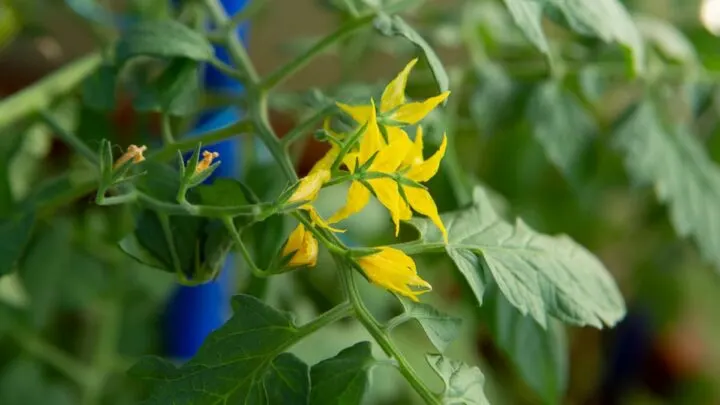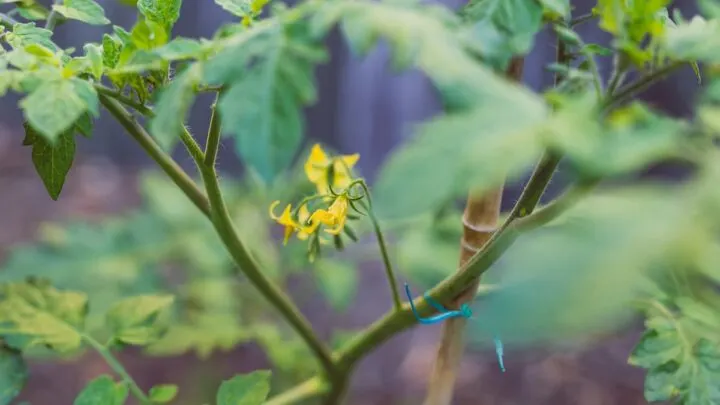Soon, tomato plants will begin flowering. If you live in an area with mild winter temperatures, flowers are probably already appearing on your tomato plants. To get the most possible fruit from your plant, you might be wondering what can be done to increase flowering in tomato plants.
You can increase tomato flowering by providing the plant with higher amounts of nitrogen. However, adding nitrogen during the fruiting stage may result in smaller tomatoes and excess foliage.

Tips To Increase Flowering In Your Tomato Plants
By increasing flowering, you require the plant to be more productive. More flowers equal more fruit. Once flowers have appeared, there are things you can do to increase pollination and fruit production, but before that stage, increasing flower production begins with proper plant care. Healthy and happy plants are the best producers.
Plant Deeply
From the beginning, whether you are starting from seed or have purchased plants, start the plant off with a good foundation. Other crops suffer when planted too deeply but not tomato plants! Tomato plant stems can be buried up to just below the first leaves.
The stems buried under the soil will sprout new roots. A larger root system means a wider network to absorb water and dissolve nutrients. This will help increase flowering and takes just a moment to do. You can also do this even if your plant is already established as tomatoes can root directly from the stem.
The plant will be better anchored into the ground and overall create a stronger and more resilient plant. If your tomatoes are already in the ground and you don’t think they were planted deeply enough, and it’s still early in the season, there’s still time to mound soil up around the tomato stems.
Sunlight
Plant tomatoes in the sunniest spot you can provide. Tomato plants need a lot of sun. This is important because tomatoes convert light from the sun into energy. This energy is used to grow taller, grow leaves, produce flowers, produce and ripen fruit.

A plant without adequate daily sun exposure won’t be able to make enough energy to do all these things to the best of its ability. The sunlight doesn’t have to be continuous. Some gardens get morning sun, followed by a period without direct sunlight, then sunlight again later on in the day, and that’s alright. What matters is the amount of overall sun the plants receive daily.
The minimum hours of sunlight for tomato plants to thrive are 6 hours. There are tomato varieties that are shade tolerant.
Prune
Pruning isn’t just about controlling the shape of the plant and alleviating issues like poor airflow or as a measure for disease prevention. Pruning leaves will cause the plant to redirect the energy it would have used to grow more foliage and use it elsewhere, like producing more flowers.
Keep in mind that there is more than one method of pruning based on the desired results. Pruning off suckers will increase harvest by redirecting energy from growing the suckers to putting out more flowers. Pruning off the top of the plant, or “topping,” will stop flower production and is used to speed up fruit ripening near the end of the season.
Pruning off just the plant’s lower leaves is not about redirecting energy. It is used to increase airflow and lower the risk of fungal infections.
Fertilize
Sometimes plants need a little extra help with flowering. When fertilizing, avoid using fertilizers that are meant for other plants. Different plants have different nutrient needs, and fertilizers are formulated for the specific plant listed on the label. Use plant food created just for tomato plants and applied exactly as suggested on the package to avoid over or under-fertilizing.
Some gardeners are not fond of using fertilizers because of pets and children. Others would rather have a more natural approach. Alternative ways to boost nutrients are by using organic fertilizers. Soils can be amended with lots of compost made from manure and leaves.

Liquid fish fertilizers get delivered to plant roots immediately and do not leave behind any signs of use on the soil surface. In addition to the major nutrients, it also contains beneficial organic matter. Be aware that liquid fish fertilizers might cause an unpleasant order in the garden for a day or two after use.
Ideally, you want a balanced fertilizer ratio, somewhere in the 10 -10 -10 NPK ratio. However, once the flowers start to emerge (and they will be in big bunches), you may want to go for more potassium and phosphorous in your fertilizer.
This helps when fruit begins to set. If you don’t switch, you may end up with flowers that won’t end up pollinating and smaller fruit because the plant has to direct its energy to everything else. Dr. Earth makes a great Tomato & Vegetable fertilizer with a 4-6-3 ratio that is excellent for all-around planting.
Water Properly
Tomato plants are easily stressed by too much or too little water. Water tomato plants several days a week and water deeply. Avoid just sprinkling the plant with a little water every day. Watering deeply will encourage roots to reach down into the ground where the soil is moist.
If you’re not sure if the plant needs to be watered, poke a finger into the soil to see if it’s dry. Useful tools like moisture meters use metal probes to measure soil moisture.
Mulch your tomatoes to keep the soil moist for longer periods in between watering. While tomato plants like water, they do not like to be waterlogged. If plants are in containers, they require more frequent watering because they dry out more easily.
Disease Management
Ideally, disease prevention is best. Cleaning tools regularly, watering from the soil line, pruning foliage that is too full or cutting off leaves are touching the soil, avoiding watering leaves, and weeding is all measures that will decrease the chances of tomato plants becoming infected with the disease. Fungicidal sprays can be applied on a regular basis as a preventative measure.
Inspect plants often so that any signs of infection or pests can be recognized early. Once symptoms of the disease are spotted, treat them immediately by cutting off affected foliage and applying the appropriate treatments.
How To Boost Fruit Production After Plants Have Flowered
Hand pollination – Tomato plants are self-pollinating, which means that one plant doesn’t depend on another plant nearby to pollinate flowers like some other plants that have to be planted in pairs to ensure fruit production. However, tomato plants still need factors like wind transfer pollen between the flowers. Sometimes, this doesn’t work out due to things like high temperatures.
Hand pollinating is easy. Many gardeners use an electric toothbrush and gently touch the flowers to cause a vibration. This is not the only method to hand pollinate. Dipping a small, soft-bristled painting brush into each flower is just as effective. You can also gently shake or blow the flowers to move the pollen around.
Plant flowers – Bees also pollinate tomato plants, so another way to increase pollination of tomato flowers is by planting flowers such as natives to attract bees.
Final Thoughts
Sometimes, we want our crops to be more productive without realizing that the variety planted isn’t a big producer. Some tomatoes are a bit of a novelty; they look great or grow large fruit but do not produce a whole lot of fruit. Consider planting high-yielding varieties.
Other times, low flower production can be due to things out of our control right at that moment, for instance, tomato varieties that don’t do well in extreme heat. Each garden is its own environment with different soil types, water retention, and insects.
What grows well in someone else’s garden may not grow well in yours, even if it’s your next-door neighbor! Finding the perfect tomato plant varieties that perform well in your particular garden may take a few seasons of trial and error to figure out. Be patient, enjoy your garden, and happy gardening!

Hi there, my name is Allie and welcome to my blog; GareningWithAllie!
Much of what you see written here is just our personal experiences with gardening. Along with the content I write here, there is also a unique collection of gardening topics covered by some of our close friends. I hope you find everything you read here to be helpful, informative, and something that can make your gardening journey the most lovely experience ever! With that said, Happy Gardening!
